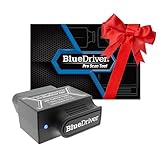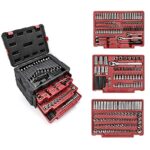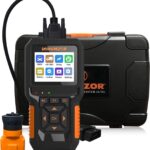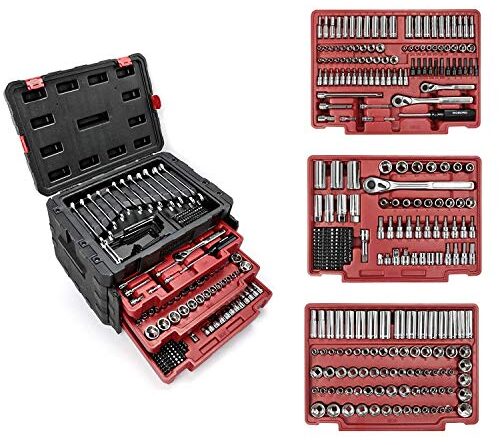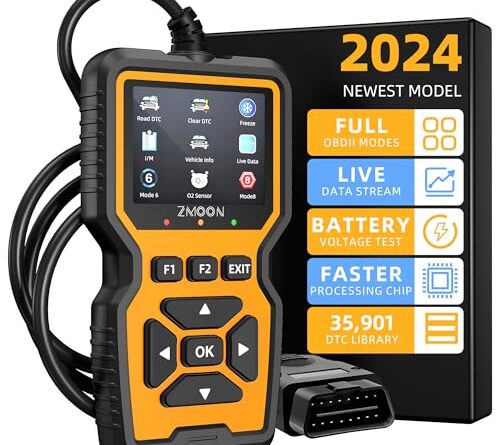
Disclaimer: This post may contain affiliate links. As an Amazon Associate, we earn from qualifying purchases.
Have you ever wondered what that device is called that mechanics use to diagnose car issues? Well, it’s called a car diagnostic tool. This handy gadget is designed to communicate with your car’s onboard computer system and provide valuable insights into any problems or malfunctions. From checking engine codes to identifying faulty sensors, a car diagnostic tool is an essential tool in a mechanic’s arsenal. So, the next time you visit an auto repair shop, you’ll know exactly what that magical device is called – a car diagnostic tool!
1. Car Diagnostic Tool Overview
1.1 Definition of a Car Diagnostic Tool
A car diagnostic tool is a device or software that helps in identifying and troubleshooting issues in a vehicle’s systems and components. It is designed to connect to the onboard computer system of a car and retrieve data and diagnostic trouble codes (DTCs) that can indicate the source of a problem. These tools provide valuable information to both professional mechanics and car owners, allowing them to diagnose and fix issues efficiently.
1.2 Importance of Car Diagnostic Tools
Car diagnostic tools play a crucial role in modern automotive repair and maintenance. They enable quick and accurate identification of problems, saving time and effort in diagnosing issues manually. These tools help in avoiding unnecessary repairs and prevent further damage to the vehicle by identifying problems early on. Car diagnostic tools also empower car owners by providing them with insights into their vehicle’s health and allowing them to make informed decisions about repairs and maintenance.
2. Types of Car Diagnostic Tools
There are various types of car diagnostic tools available in the market, each designed for specific purposes and levels of complexity. Let’s explore some of the most commonly used diagnostic tools:
2.1 OBD-II Scanners
OBD-II (Onboard Diagnostics) scanners are one of the most prevalent types of car diagnostic tools. These tools connect to the OBD-II port in a vehicle, allowing them to communicate with the onboard computer system. OBD-II scanners can read and interpret diagnostic trouble codes, retrieve real-time data, and perform system tests to diagnose problems accurately.
2.2 Code Readers
Code readers are relatively basic diagnostic tools that specialize in reading and clearing diagnostic trouble codes. They are an affordable option for car owners who want to monitor their vehicle’s health and identify any potential issues.
2.3 Diagnostic Software
Diagnostic software is a computer-based tool that offers advanced diagnostic capabilities. It is typically used by professional mechanics and technicians in conjunction with specialized hardware. Diagnostic software provides in-depth analysis of vehicle systems and components, along with features like graphing, data logging, and advanced troubleshooting techniques.
2.4 Diagnostic Scan Tools
Diagnostic scan tools are comprehensive diagnostic devices that combine the functionality of code readers and live data scanners. They offer a wide range of features, including reading and clearing codes, retrieving real-time data, performing system tests, and advanced diagnostic functions like programming and coding.
2.5 Multimeters
Multimeters are versatile diagnostic tools widely used in the automotive field. They can measure various electrical parameters, such as voltage, current, and resistance. Multimeters are essential for diagnosing electrical issues in a vehicle, such as faulty sensors, wiring problems, and malfunctioning electronic components.
2.6 Oscilloscopes
Oscilloscopes are advanced diagnostic tools used to analyze and troubleshoot complex electrical and electronic circuits. They display electrical waveforms graphically, allowing technicians to visualize the behavior of signals and identify abnormalities. Oscilloscopes are particularly useful in diagnosing problems with sensors, actuators, ignition systems, and electronic control units.
2.7 Inspection Cameras
Inspection cameras, also known as borescopes or endoscopes, are tools equipped with a camera and a flexible tube that can be inserted into tight spaces. They allow technicians to visually inspect hidden areas inside the vehicle, such as engine compartments, exhaust systems, and hard-to-reach components. Inspection cameras are invaluable for detecting leaks, corrosion, and mechanical damage.
2.8 TPMS Tools
TPMS (Tire Pressure Monitoring System) tools are specifically designed to diagnose and troubleshoot issues related to a vehicle’s tire pressure sensors. These tools can read and reset TPMS codes, detect faulty sensors, and calibrate the system to ensure accurate tire pressure readings.
Battery testers are diagnostic tools used to assess the health of a vehicle’s battery. They measure the battery’s voltage, capacity, and overall condition to determine if it needs charging, replacement, or maintenance.
2.10 Smoke Machines
Smoke machines are specialized diagnostic tools used to detect vacuum and evaporative leaks in a vehicle. These machines generate a controlled amount of smoke, which is then introduced into the vehicle’s intake or fuel system. By observing where the smoke escapes, technicians can pinpoint the location of leaks and address them accordingly.
3. OBD-II Scanners
3.1 Introduction to OBD-II Scanners
OBD-II scanners are instrumental in diagnosing and troubleshooting issues in modern vehicles. They are designed to communicate with the onboard computer system, known as the OBD-II system, which monitors and controls various components and systems. OBD-II scanners retrieve valuable data from the system, including diagnostic trouble codes (DTCs), real-time sensor data, and system parameters.
3.2 How OBD-II Scanners Work
OBD-II scanners operate by connecting to the OBD-II port, which is typically located under the dashboard or near the driver’s seat. The scanner establishes communication with the vehicle’s onboard computer system, allowing it to retrieve and interpret data. The OBD-II system constantly monitors various components, sensors, and subsystems in the vehicle, and when an issue or malfunction occurs, it records a corresponding DTC. The scanner reads these codes and provides information about the specific problem.
3.3 Features and Functions of OBD-II Scanners
OBD-II scanners offer a wide range of features and functions that aid in vehicle diagnostics. These include:
- Reading and clearing diagnostic trouble codes (DTCs): OBD-II scanners allow users to retrieve and clear DTCs from the vehicle’s onboard computer system. Clearing the codes can turn off the “Check Engine” light.
- Real-time data monitoring: OBD-II scanners can display real-time sensor data, allowing users to monitor various parameters, such as engine RPM, coolant temperature, fuel trim, and oxygen sensor readings. This feature helps in identifying anomalies and performance issues.
- Freeze frame data: OBD-II scanners can capture and store freeze frame data, which provides a snapshot of the vehicle’s parameters at the time a fault occurred. This information is valuable for diagnosing intermittent issues.
- O2 sensor testing: Some OBD-II scanners offer the ability to perform O2 sensor tests, allowing users to evaluate the efficiency of the vehicle’s oxygen sensors.
- Onboard monitoring tests: OBD-II scanners can initiate and monitor various onboard tests, such as the EVAP system, oxygen sensor heater, and catalytic converter. These tests help in detecting potential issues and ensuring the vehicle meets emission standards.
3.4 Benefits of OBD-II Scanners
OBD-II scanners offer numerous benefits for both professional mechanics and car owners:
- Time and cost savings: By quickly identifying the source of a problem, OBD-II scanners save time that would otherwise be spent manually diagnosing issues. This leads to faster repairs, reduced labor costs, and minimized vehicle downtime.
- Accurate diagnostics: OBD-II scanners provide precise information about the specific problem or fault, enabling technicians to address the root cause of the issue rather than relying on guesswork. This improves the accuracy of repairs and reduces the risk of misdiagnosis.
- Empowering car owners: OBD-II scanners provide car owners with insights into their vehicle’s health and performance. They enable informed decision-making regarding repairs, maintenance, and when to seek professional assistance.
3.5 Popular OBD-II Scanners in the Market
There are several reputable OBD-II scanners available in the market, each offering unique features and capabilities. Some popular options include:
These scanners vary in price range, functionality, and compatibility with different vehicle makes and models. It is crucial to research and choose an OBD-II scanner that suits your specific needs and requirements.
4. Code Readers
4.1 What are Code Readers?
Code readers are simple and straightforward diagnostic tools that focus primarily on reading and clearing diagnostic trouble codes (DTCs). They serve as an entry-level option for car owners who want to monitor their vehicle’s health and identify potential issues without the need for advanced diagnostic features.
4.2 Key Features of Code Readers
Code readers usually offer the following core features:
- DTC retrieval and clearing: Code readers can access the vehicle’s onboard computer system and retrieve the stored diagnostic trouble codes. They also have the capability to clear the codes, turning off the “Check Engine” light.
- Code definitions: Most code readers provide basic code definitions, allowing users to understand the nature of the problem indicated by the code. These definitions may be generic or manufacturer-specific.
- Basic live data monitoring: Some code readers can display real-time sensor data, such as engine RPM, vehicle speed, and coolant temperature. However, the data displayed by code readers is typically more limited compared to comprehensive OBD-II scanners.
4.3 How Code Readers Help in Car Diagnostics
Code readers play a vital role in identifying and diagnosing problems in a vehicle’s electronic systems. By retrieving and interpreting diagnostic trouble codes, they provide valuable information about the specific issues that triggered the codes. This information helps car owners identify potential areas of concern and decide whether they can address the problem independently or seek professional assistance.
4.4 Pros and Cons of Code Readers
Code readers offer several advantages and limitations:
Pros:
- Affordability: Code readers are generally less expensive compared to more advanced diagnostic tools, making them accessible to car owners on a budget.
- Simplicity: Code readers are user-friendly, with straightforward interfaces that make them easy to operate, even for those with limited technical knowledge.
- Basic diagnostic capabilities: While code readers may not offer the same level of functionality as more advanced tools, they can still provide valuable information about the vehicle’s health and potentially identify issues early on.
Cons:
- Limited features: Code readers are primarily designed for reading and clearing diagnostic trouble codes. They may lack advanced features, such as real-time data monitoring, freeze frame data retrieval, and system testing capabilities.
- Lack of detailed code definitions: Some code readers provide only basic code definitions, which may not give users a comprehensive understanding of the underlying issue. This can make it challenging to determine the necessary steps for repair or maintenance.
- Compatibility limitations: Code readers may not be compatible with all vehicle makes and models, especially older or less common ones. It is essential to ensure that the code reader supports the specific vehicle you intend to diagnose.
5. Diagnostic Software
5.1 Definition and Function of Diagnostic Software
Diagnostic software refers to computer-based applications designed to interact with a vehicle’s onboard computer system and perform comprehensive diagnostic procedures. This software is typically used in conjunction with specialized hardware, such as OBD-II interfaces, to establish communication with a vehicle’s electronic systems.
The primary function of diagnostic software is to retrieve diagnostic trouble codes (DTCs), read real-time data, and perform advanced diagnostic tests to identify and address problems in a vehicle. Diagnostic software provides in-depth insights into the health and performance of various systems and components, enabling professional technicians to make accurate diagnoses and recommend appropriate repairs or maintenance.
5.2 Different Types of Diagnostic Software
There are various types of diagnostic software available, each tailored to specific vehicle makes, models, and systems. Some common types include:
- Manufacturer-specific diagnostic software: This software is developed by vehicle manufacturers and is designed to work with their specific models. It provides comprehensive access to vehicle-specific data and allows technicians to perform advanced functions like programming, coding, and module reprogramming.
- Aftermarket diagnostic software: Aftermarket diagnostic software covers a broader range of vehicle makes and models. It offers features similar to manufacturer-specific software but may not provide the same level of in-depth system access.
- General diagnostic software: General diagnostic software is compatible with a wide range of vehicles, regardless of the make and model. It provides basic diagnostic functionality for reading codes, retrieving real-time data, and performing system tests.
5.3 Benefits of Diagnostic Software
Diagnostic software offers several key advantages in the field of vehicle diagnostics:
- Enhanced diagnostic capabilities: Diagnostic software provides professional technicians with comprehensive access to a vehicle’s systems and components. This allows for detailed analysis and diagnosis of complex issues that may not be apparent with basic diagnostic tools.
- Accurate and reliable results: Diagnostic software leverages advanced algorithms and databases to interpret diagnostic trouble codes and provide accurate diagnostic information. This helps technicians identify the precise cause of a problem and recommend appropriate solutions.
- Time and cost savings: Diagnostic software streamlines the diagnostic process, reducing the time and effort required to identify and troubleshoot problems. This results in faster repairs, minimized labor costs, and improved overall productivity.
- Firmware updates and module programming: Some diagnostic software allows technicians to update vehicle firmware, reflash modules, and perform coding and programming functions. This ensures that vehicles are running with the latest software versions and can even enable additional features or performance enhancements.
5.4 Limitations of Diagnostic Software
While diagnostic software offers significant benefits, it also has certain limitations:
- Cost: Diagnostic software can be quite expensive, especially for manufacturer-specific software. The initial investment and ongoing subscription costs may deter small repair shops and individual car owners from utilizing advanced diagnostic software.
- Complexity: Diagnostic software often requires a certain level of technical expertise to operate. Understanding the software’s capabilities, navigating the user interface, and interpreting diagnostic results may be challenging for individuals without proper training or experience.
- Compatibility: Diagnostic software may not be compatible with all vehicle makes, models, and systems. This limits its usefulness for comprehensive vehicle diagnostics across different manufacturers.
6. Diagnostic Scan Tools
6.1 Introduction to Diagnostic Scan Tools
Diagnostic scan tools are comprehensive devices that combine the functionalities of code readers and live data scanners. They offer a wide range of features and capabilities to diagnose and troubleshoot issues in modern vehicles. Diagnostic scan tools connect to the vehicle’s onboard computer system, allowing users to retrieve diagnostic trouble codes (DTCs), interpret real-time sensor data, perform system tests, and access advanced diagnostic functions.
6.2 Features of Diagnostic Scan Tools
Diagnostic scan tools typically offer a variety of features and capabilities that aid in vehicle diagnostics:
- DTC retrieval and clearing: Diagnostic scan tools can retrieve and clear diagnostic trouble codes stored in the vehicle’s onboard computer system. Clearing the codes can turn off the “Check Engine” light.
- Live data monitoring: Diagnostic scan tools display real-time sensor data, allowing users to observe various parameters, such as engine RPM, coolant temperature, oxygen sensor readings, and more. This feature helps technicians identify abnormal values or fluctuations that may indicate a problem.
- Freeze frame data: Diagnostic scan tools can capture and store freeze frame data, providing a snapshot of the vehicle’s parameters at the time a fault occurred. This information is valuable for diagnosing intermittent issues and understanding the context in which the fault was triggered.
- System testing: Diagnostic scan tools can initiate and monitor various system tests, such as the EVAP system, oxygen sensor heater, catalytic converter, and more. These tests help in detecting potential issues and ensuring the vehicle’s systems meet performance and emission standards.
- Programming and coding functions: Some diagnostic scan tools offer advanced capabilities like programming and coding. This allows users to program new modules, update firmware, reflash control units, and perform advanced customizations.
6.3 How Diagnostic Scan Tools Aid in Car Troubleshooting
Diagnostic scan tools are powerful aids in the troubleshooting process, assisting technicians in identifying and resolving vehicle issues. By retrieving diagnostic trouble codes, interpreting sensor data, and performing system tests, diagnostic scan tools provide vital diagnostic information that helps pinpoint the root cause of a problem. Technicians can then take appropriate steps to repair or replace faulty components, ensuring the vehicle is restored to optimal performance.
Diagnostic scan tools offer real-time monitoring of sensor data, allowing technicians to observe how various systems and components are functioning together. This helps in identifying abnormal readings or discrepancies that may indicate underlying issues. System tests performed by diagnostic scan tools provide further insights into the integrity and performance of critical vehicle systems, enabling the technician to diagnose and address potential problems before they escalate.
6.4 Pros and Cons of Diagnostic Scan Tools
Diagnostic scan tools provide numerous benefits, but they also have limitations. Let’s examine the pros and cons:
Pros:
- Comprehensive diagnostic capability: Diagnostic scan tools offer a wide range of features and functions, allowing technicians to perform in-depth diagnostics. They provide detailed information about the vehicle’s health, helping technicians accurately identify and address problems.
- Real-time data monitoring: Diagnostic scan tools display real-time sensor data, enabling technicians to observe and analyze critical parameters. This real-time monitoring helps identify anomalies and facilitates efficient troubleshooting.
- Advanced system testing: Diagnostic scan tools go beyond simple code reading and offer extensive system testing capabilities. These tests provide a comprehensive assessment of vehicle systems, helping to identify hidden faults and potential areas of concern.
- Programming and coding: Some diagnostic scan tools support advanced functions like programming and coding. This allows technicians to update firmware, reprogram control units, and even customize certain system parameters to meet specific requirements.
Cons:
- Cost: Diagnostic scan tools tend to be more expensive compared to basic code readers or OBD-II scanners. The initial investment can be substantial, especially for high-end or manufacturer-specific tools.
- Complexity: Diagnostic scan tools often require a certain level of technical expertise to operate effectively. They come with detailed menus, complex user interfaces, and advanced diagnostic functions that may be overwhelming for individuals without adequate training or experience.
- Compatibility limitations: Some diagnostic scan tools are designed to work only with specific vehicle makes or models. It is crucial to ensure compatibility before purchasing a diagnostic scan tool. Additionally, compatibility with newer vehicle models and advanced systems may be limited.
These diagnostic scan tools come from reputable manufacturers and are trusted by professional technicians worldwide. Consider factors like compatibility, features, and user reviews when selecting a diagnostic scan tool that suits your specific needs.
7. Multimeters
7.1 Explanation of Multimeters in Car Diagnostics
Multimeters are versatile diagnostic tools used extensively in the automotive field for electrical troubleshooting and diagnosis. These handheld devices can measure various electrical parameters, such as voltage, current, resistance, and continuity. In car diagnostics, multimeters play a crucial role in identifying electrical issues and verifying the integrity of electrical circuits and components.
7.2 Types of Multimeters Used in Automotive Field
There are primarily two types of multimeters used in the automotive field: analog multimeters and digital multimeters.
Analog Multimeters:
Analog multimeters use a needle or pointer to indicate the measured value on a scale. They have a physical dial or rotary selector for selecting the desired electrical parameter, such as voltage, current, or resistance. Analog multimeters are less commonly used in modern automotive diagnostics due to their limitations in accuracy and readability.
Digital Multimeters:
Digital multimeters (DMMs) are the preferred choice for automotive diagnostics. They use a digital display to present measurement values and offer enhanced accuracy, versatility, and ease of use. Digital multimeters allow users to select various functions, including AC/DC voltage measurements, current measurements, resistance measurements, continuity tests, and diode tests.
7.3 Advantages of Multimeters for Car Diagnosis
Multimeters offer numerous advantages when it comes to car diagnostics:
- Versatility: Multimeters can measure a wide range of electrical parameters, making them valuable for diagnosing various electrical issues in a vehicle. Whether it’s measuring battery voltage, testing a sensor, or checking wiring continuity, a multimeter can provide critical information.
- Accuracy: Digital multimeters provide high accuracy and precise measurements, allowing technicians to assess the health and performance of electrical components and circuits accurately.
- User-friendly operation: Digital multimeters are generally easy to use, with clear digital displays and intuitive controls. They offer various measurement ranges and functions, enabling users to adjust settings based on the specific diagnostic requirements.
- Portability: Multimeters are compact, lightweight, and portable, allowing technicians to carry them conveniently to different locations within a vehicle. This makes them ideal for diagnosing electrical issues in tight spaces.
7.4 Limitations of Multimeters
While multimeters are invaluable tools in car diagnostics, they do have some limitations:
- Limited visualizations: Multimeters provide numeric readings but lack the graphical representations offered by more advanced diagnostic tools like oscilloscopes. This hampers the ability to observe waveforms and analyze complex electrical signals.
- Single-point measurements: Multimeters provide measurements at a specific point in an electrical circuit, limiting the ability to observe changes or fluctuations over time.
- Inability to capture transient events: Multimeters are not designed to capture rapid or transient events that occur within milliseconds. They are better suited for steady-state measurements.








